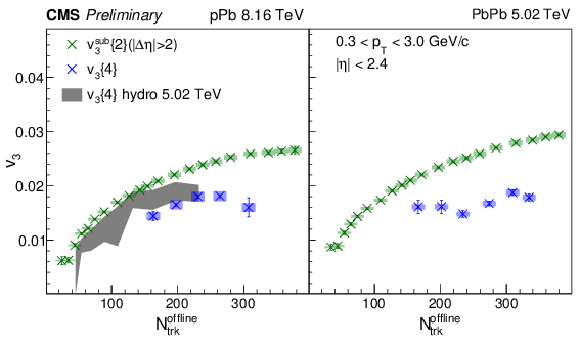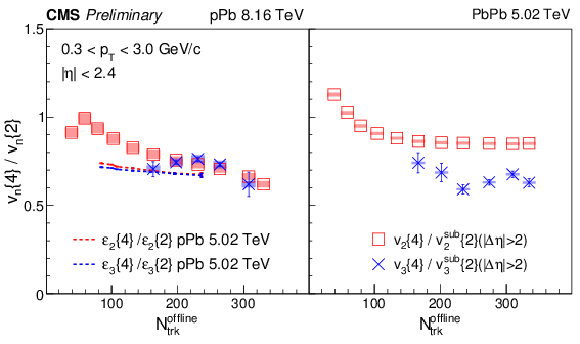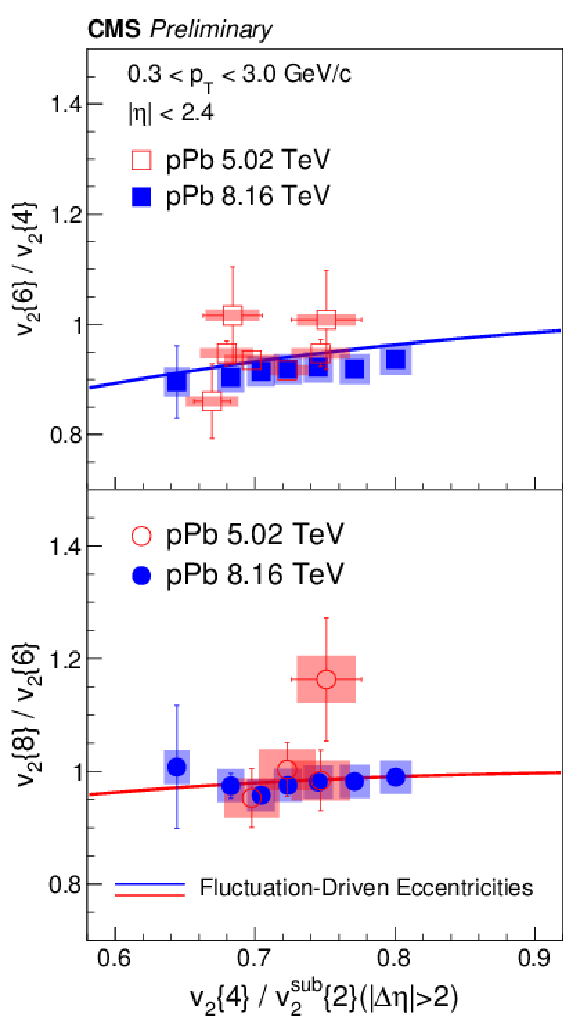

Compact Muon Solenoid
LHC, CERN
| CMS-PAS-HIN-17-004 | ||
| Multiparticle correlations and higher order harmonics in pPb collisions at √sNN= 8.16 TeV | ||
| CMS Collaboration | ||
| May 2018 | ||
| Abstract: The second- and third-order azimuthal anisotropy Fourier harmonics are studied in pPb collisions at √sNN= 8.16 TeV over a wide range of event multiplicities. The second-order, "elliptic'' harmonic moment is obtained through four-, six-, and eight-particle correlations and the third-order, "triangular'' harmonic moment is studied using four-particle correlations. The data were collected by the CMS experiment during the 2016 LHC run. A sample of peripheral PbPb collisions at √sNN= 5.02 TeV, covering a similar range of event multiplicities to the pPb results, is also analyzed. Theoretical predictions that assume a hydrodynamic evolution of the created medium with initial-state density fluctuations are compared to the experimental results. | ||
|
Links:
CDS record (PDF) ;
CADI line (restricted) ;
These preliminary results are superseded in this paper, PRC 101 (2020) 014912. The superseded preliminary plots can be found here. |
||
| Figures | |

png pdf |
Figure 1:
The multiparticle v2{4,6,8} are shown for pPb 8.16 TeV (left) and PbPb 5.02 TeV (right) as a function of Nofflinetrk. Two-particle results vsub2{2}(|Δη|>2) are from Ref. [38]. Error bars and shaded boxes denote statistical and systematic uncertainties, respectively. |

png pdf |
Figure 2:
The multiparticle v3{4} are shown for pPb 8.16 TeV (left) and PbPb 5.02 TeV (right) as a function of Nofflinetrk. Two-particle results vsub3{2}(|Δη|>2) are from Ref. [38]. Error bars and shaded boxes denote statistical and systematic uncertainties, respectively. The shaded area shows the hydrodynamic prediction of v3{4} in pPb collisions at √sNN= 5.02 TeV [44]. |

png pdf |
Figure 3:
The ratios of four- and two-particle harmonics (v2{4}/v2{2} and v3{4}/v3{2}) are shown for pPb √sNN= 8.16 TeV (left) and PbPb √sNN= 5.02 TeV (right) as a function of Nofflinetrk. Error bars and shaded boxes denote statistical and systematic uncertainties, respectively. The dashed curves show a hydrodynamics motivated initial-state fluctuation calculation for pPb collisions at √sNN= 5.02 TeV [46]. |

png pdf |
Figure 4:
Cumulant ratios v2{6}/v2{4} (top) and v2{8}/v2{6} (bottom) as a function of v2{4}/v2{2} in pPb collisions at √sNN= 5.02 TeV and 8.16 TeV. Error bars and shaded areas denote statistical and systematic uncertainties, respectively. The solid curves show the expected behavior based on a hydrodynamics motivated study of the role of initial-state fluctuations [35]. |
| Summary |
| In summary, the azimuthal anisotropy for pPb collisions at √sNN= 8.16 TeV and PbPb collisions at √sNN= 5.02 TeV are studied as a function of the final-state particle densities by the CMS experiment. The v2 Fourier coefficient is determined using cumulants obtained with four-, six-, and eight-particle correlations with greatly increased precision compared to previous measurements. The higher order v3{4} coefficient is reported for the first time for a small system. For pPb collisions, the ratios v2{4}/v2{2} and v3{4}/v3{2} are comparable, consistent with a purely fluctuation-driven origin for the azimuthal asymmetry. Both the pPb and PbPb systems have very similar v3 coefficients for all cumulant orders, indicating a similar, fluctuation-driven origin. In contrast, both the magnitude of the v2 coefficients and the v2{4}/v2{2} ratio is larger for PbPb collisions, as would be expected if the global collision geometry dominates these results. The present results confirm significant non-Gaussian components to the fluctuation behavior and thereby help to explore the role of fluctuations on the initial-state eccentricities. |
| References | ||||
| 1 | PHOBOS Collaboration | System size dependence of cluster properties from two-particle angular correlations in Cu+Cu and Au+Au collisions at √sNN= 200 GeV | PRC 81 (2010) 024904 | 0812.1172 |
| 2 | STAR Collaboration | Distributions of charged hadrons associated with high transverse momentum particles in pp and Au+Au collisions at √sNN= 200 GeV | PRL 95 (2005) 152301 | nucl-ex/0501016 |
| 3 | STAR Collaboration | Long range rapidity correlations and jet production in high energy nuclear collisions | PRC 80 (2009) 064912 | 0909.0191 |
| 4 | PHOBOS Collaboration | High transverse momentum triggered correlations over a large pseudorapidity acceptance in Au+Au collisions at √sNN= 200 GeV | PRL 104 (2010) 062301 | 0903.2811 |
| 5 | CMS Collaboration | Long-range and short-range dihadron angular correlations in central PbPb collisions at a nucleon-nucleon center of mass energy of 2.76 TeV | JHEP 07 (2011) 076 | CMS-HIN-11-001 1105.2438 |
| 6 | CMS Collaboration | Centrality dependence of dihadron correlations and azimuthal anisotropy harmonics in PbPb collisions at √sNN = 2.76 TeV | EPJC 72 (2012) 2012 | CMS-HIN-11-006 1201.3158 |
| 7 | ALICE Collaboration | Elliptic flow of charged particles in Pb-Pb collisions at 2.76 TeV | PRL 105 (2010) 252302 | 1011.3914 |
| 8 | ATLAS Collaboration | Measurement of the azimuthal anisotropy for charged particle production in √sNN= 2.76 TeV lead-lead collisions with the ATLAS detector | PRC 86 (2012) 014907 | 1203.3087 |
| 9 | CMS Collaboration | Measurement of the elliptic anisotropy of charged particles produced in PbPb collisions at √sNN= 2.76 TeV | PRC 87 (2013) 014902 | CMS-HIN-10-002 1204.1409 |
| 10 | B. Alver and G. Roland | Collision geometry fluctuations and triangular flow in heavy-ion collisions | PRC 81 (2010) 054905 | 1003.0194 |
| 11 | B. H. Alver, C. Gombeaud, M. Luzum, and J.-Y. Ollitrault | Triangular flow in hydrodynamics and transport theory | PRC 82 (2010) 034913 | 1007.5469 |
| 12 | B. Schenke, S. Jeon, and C. Gale | Elliptic and triangular flow in event-by-event (3+1)D viscous hydrodynamics | PRL 106 (2011) 042301 | 1009.3244 |
| 13 | Z. Qiu, C. Shen, and U. Heinz | Hydrodynamic elliptic and triangular flow in Pb-Pb collisions at √sNN= 2.76 ATeV | PLB 707 (2012) 151 | 1110.3033 |
| 14 | CMS Collaboration | Observation of Long-Range Near-Side Angular Correlations in Proton-Proton Collisions at the LHC | JHEP 09 (2010) 091 | CMS-QCD-10-002 1009.4122 |
| 15 | ATLAS Collaboration | Observation of Long-Range Elliptic Azimuthal Anisotropies in √s= 13 and 2.76 TeVpp Collisions with the ATLAS Detector | PRL 116 (2016) 172301 | 1509.04776 |
| 16 | CMS Collaboration | Measurement of long-range near-side two-particle angular correlations in pp collisions at √s= 13 TeV | PRL 116 (2016) 172302 | CMS-FSQ-15-002 1510.03068 |
| 17 | CMS Collaboration | Observation of long-range near-side angular correlations in proton-lead collisions at the LHC | PLB 718 (2013) 795 | CMS-HIN-12-015 1210.5482 |
| 18 | ALICE Collaboration | Long-range angular correlations on the near and away side in p-Pb collisions at √sNN= 5.02 TeV | PLB 719 (2013) 29 | 1212.2001 |
| 19 | ATLAS Collaboration | Observation of Associated Near-Side and Away-Side Long-Range Correlations in √sNN= 5.02 TeV Proton-Lead Collisions with the ATLAS Detector | PRL 110 (2013) 182302 | 1212.5198 |
| 20 | LHCb Collaboration | Measurements of long-range near-side angular correlations in √sNN= 5 TeV proton-lead collisions in the forward region | PLB 762 (2016) 473 | 1512.00439 |
| 21 | PHENIX Collaboration | Measurements of Multiparticle Correlations in d+Au Collisions at 200, 62.4, 39, and 19.6 GeV and p+Au Collisions at 200 GeV and Implications for Collective Behavior | PRL 120 (2018) 062302 | 1707.06108 |
| 22 | B. Schenke and R. Venugopalan | Eccentric protons? Sensitivity of flow to system size and shape in p+p, p+Pb and Pb+Pb collisions | PRL 113 (2014) 102301 | 1405.3605 |
| 23 | P. Bozek | Collective flow in p-Pb and d-Pd collisions at TeV energies | PRC 85 (2012) 014911 | 1112.0915 |
| 24 | P. Bozek and W. Broniowski | Correlations from hydrodynamic flow in p-Pb collisions | PLB 718 (2013) 1557 | 1211.0845 |
| 25 | K. Dusling and R. Venugopalan | Explanation of systematics of CMS p+Pb high multiplicity di-hadron data at √sNN= 5.02 TeV | PRD 87 (2013) 054014 | 1211.3701 |
| 26 | K. Dusling, M. Mace, and R. Venugopalan | Parton model description of multiparticle azimuthal correlations in pA collisions | PRD 97 (2018) 016014 | 1706.06260 |
| 27 | N. Borghini, P. M. Dinh, and J.-Y. Ollitrault | A New method for measuring azimuthal distributions in nucleus-nucleus collisions | PRC 63 (2001) 054906 | nucl-th/0007063 |
| 28 | CMS Collaboration | Evidence for collectivity in pp collisions at the LHC | PLB 765 (2017) 193 | CMS-HIN-16-010 1606.06198 |
| 29 | CMS Collaboration | Evidence for Collective Multiparticle Correlations in p-Pb Collisions | PRL 115 (2015) 012301 | CMS-HIN-14-006 1502.05382 |
| 30 | CMS Collaboration | Multiplicity and transverse momentum dependence of two- and four-particle correlations in pPb and PbPb collisions | PLB 724 (2013) 213 | CMS-HIN-13-002 1305.0609 |
| 31 | ATLAS Collaboration | Measurement with the ATLAS detector of multi-particle azimuthal correlations in p+Pb collisions at √sNN= 5.02 TeV | PLB 725 (2013) 60 | 1303.2084 |
| 32 | ALICE Collaboration | Multiparticle azimuthal correlations in p-Pb and Pb-Pb collisions at the CERN Large Hadron Collider | PRC 90 (2014) 054901 | 1406.2474 |
| 33 | CMS Collaboration | Measurement of higher-order harmonic azimuthal anisotropy in PbPb collisions at √sNN= 2.76 TeV | PRC 89 (2014) 044906 | CMS-HIN-11-005 1310.8651 |
| 34 | A. Bilandzic, R. Snellings, and S. Voloshin | Flow analysis with cumulants: Direct calculations | PRC 83 (2011) 044913 | 1010.0233 |
| 35 | L. Yan and J.-Y. Ollitrault | Universal fluctuation-driven eccentricities in proton-proton, proton-nucleus and nucleus-nucleus collisions | PRL 112 (2014) 082301 | 1312.6555 |
| 36 | CMS Collaboration | The CMS experiment at the CERN LHC | JINST 3 (2008) S08004 | CMS-00-001 |
| 37 | Geant4 Collaboration | Geant4: A simulation toolkit | NIMA 506 (2003) 250 | |
| 38 | CMS Collaboration | Observation of Correlated Azimuthal Anisotropy Fourier Harmonics in pp and p+Pb Collisions at the LHC | PRL 120 (2018) 092301 | CMS-HIN-16-022 1709.09189 |
| 39 | CMS Collaboration | Description and performance of track and primary-vertex reconstruction with the CMS tracker | JINST 9 (2014) P10009 | CMS-TRK-11-001 1405.6569 |
| 40 | CMS Collaboration | Pseudorapidity and transverse momentum dependence of flow harmonics in pPb and PbPb collisions | Submitted to PRC | CMS-HIN-15-008 1710.07864 |
| 41 | A. Bilandzic et al. | Generic framework for anisotropic flow analyses with multi-particle azimuthal correlations | PRC 89 (2014) 064904 | 1312.3572 |
| 42 | PHOBOS Collaboration | Importance of correlations and fluctuations on the initial source eccentricity in high-energy nucleus-nucleus collisions | PRC 77 (2008) 014906 | 0711.3724 |
| 43 | J.-Y. Ollitrault, A. M. Poskanzer, and S. A. Voloshin | Effect of flow fluctuations and nonflow on elliptic flow methods | PRC 80 (2009) 014904 | 0904.2315 |
| 44 | I. Kozlov et al. | Transverse momentum structure of pair correlations as a signature of collective behavior in small collision systems | 1405.3976 | |
| 45 | J. E. Bernhard et al. | Applying Bayesian parameter estimation to relativistic heavy-ion collisions: simultaneous characterization of the initial state and quark-gluon plasma medium | PRC 94 (2016) 024907 | 1605.03954 |
| 46 | G. Giacalone, J. Noronha-Hostler, and J.-Y. Ollitrault | Relative flow fluctuations as a probe of initial state fluctuations | PRC 95 (2017) 054910 | 1702.01730 |
| 47 | CMS Collaboration | Evidence for transverse momentum and pseudorapidity dependent event plane fluctuations in PbPb and pPb collisions | PRC 92 (2015) 034911 | CMS-HIN-14-012 1503.01692 |

|
Compact Muon Solenoid LHC, CERN |

|

|

|

|

|

|